September 4, 2020
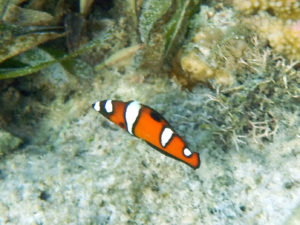
The Zanzibar juvenile yellowtail coris. ©Susan Scott
I often save fish pictures that aren’t particularly good in hopes that they might help me identify a species. This is especially so with wrasses.
While looking for the pilot fish in my 2019 Zanzibar photos, I came across a mediocre picture of the same wrasse species, or so I thought, that I also photographed last week here in my favorite snorkeling spot on the North Shore.
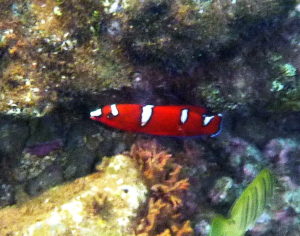
My North Shore yellowtail coris resembles the Zanzibar fish above, but you can see some differences. With wrasses, though, it’s hard to tell what that means. © Susan Scott
In Hawaii, the fish’s common name in English is yellowtail coris, in Hawaiian hinalea ‘akilolo, and in science speak Coris gaimard.
I’ve been watching this juvenile fish since mid-July, but at my slightest approach, the fast and wary youngster dashes to the nearest hideout, resulting in a series of lousy pictures. But I know where it lives and visit there often.
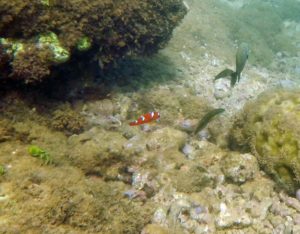
My baby wrasse hangs out near a raised coral head that offers a good hiding place. ©Susan Scott
Besides being striking in colors and patterns, another amazing aspect of the species is that the juveniles look nothing—and I mean nothing— like the adults.
I had no pictures of an adult–but I do now. This week, I spotted a female, and in chasing her until I was exhausted, I learned that the equally-stunning adult females are as shy as the kids.
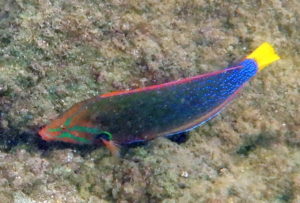
Female yellowtail coris. ©Susan Scott
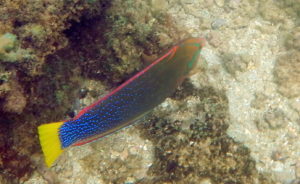
A bright yellow tail is the sure sign of an adult yellowtail wrasse, both male and female. Here the female is giving me a good view of her rear end. ©Susan Scott
I suspect the same of the males, but I don’t know, because I haven’t seen one. Now that I’ve done some reading on the species, though, I think that I’ll recognize a male yellowtail coris when I see one. Or not. Wrasses are so hard to identify, I’m never sure I got it right.
With 43 species (15 of those endemics), the wrasse family is the second largest fish family in Hawaii (gobies are first.) But the large number of species is only part of the problem in identifying these fish. Most wrasses have different colors and patterns during their various growth stages, and a mix of those in transition. In addition, adult males are different from adult females. See many of these phases in Keoki and Yuko Stender’s outstanding photos at bit.ly/3jIURK6
As red, white, and black juvenile yellowtail wrasses grow up, their colors change from the tail forward, with the white snout spot the last to go. But if an adult harasses a budding adolescent, it can revert to its immature form. (As sometimes occurs in our own species.)
After these fish reach adulthood, their colors can still be deceiving, because female wrasses sometimes turn into males, depending on the reef community’s need, and again change colors.
Because of this remarkable variation, it’s unsurprising that juveniles, males, and females of the same species received different scientific names. Since 1824, the yellowtail coris has had at least 12 scientific names (bit.ly/3546Cqu). Name issues are resolved these days with DNA studies, but for many of us recreational fish watchers, identifying what we saw can be a challenge.
All wrasses are meat eaters, either crushing snails, shrimp, sea urchins and other invertebrates, or snagging animal plankton as it drifts about. To find food, the yellowtail coris occasionally pushes rocks aside, and will bang sea urchins against rocks to break the spines off for easier eating. Local marine biologists Bruce Carlson and Marj Awai caught that behavior in this excellent video, bit.ly/3lIPkVr, featuring a juvenile, female and male off the Big Island’s Kona coast.
One identifying feature of all wrasses is a continuous fin running down their entire backs. Most wrasse bodies are widest in the middle and taper at both ends. As for colors, well, good luck.
It was my good luck that last night I dreamed about the differences in my two photos of the Zanzibar and Waialua fish. Early this morning, I jumped out of bed, searched the Internet for African yellowtail coris and found that the Indian Ocean hosts a similar fish called Coris cuvieri. One scientific journal article calls these two close relatives sister species.
Ancient Hawaiian priests used the yellowtail coris as a treatment for brain diseases. My brain disease is fear-of-naming-wrasses, a condition I’ve suffered since my long-ago ichthyology course at UH. Hopefully, reading, writing about, and sharing my blurry pictures of the yellowtail coris is a step toward a cure.
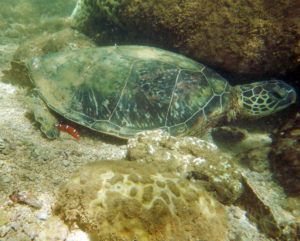
Just before I posted this article, I went snorkeling, and found my fish friend in its usual territory. This time its hiding place was occupied by the turtle that often rests here. I couldn’t get close without disturbing the turtle and left the two in peace. © Susan Scott